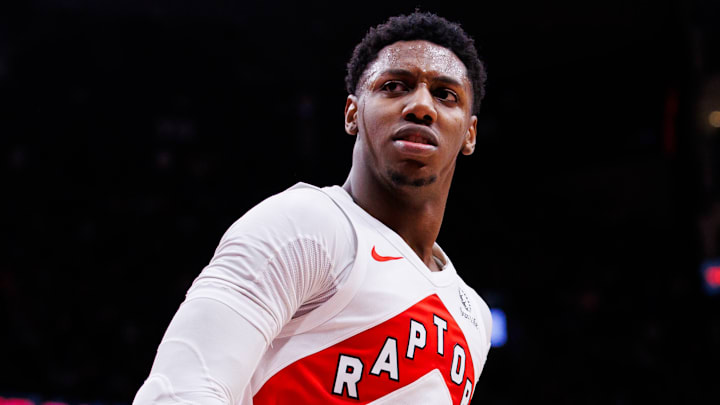RJ Barrett is obviously a talented player. He has underrated on-ball skills as a shot creator and playmaker and has taken a step up in his career since landing on his hometown Toronto Raptors. For yet another year, however, a team has completely ignored what Barrett truly needs to thrive.
The modern NBA is about spacing. Perhaps once upon a time it was about strength and size and moxie, but the name of the game in this century is spacing. How are you using the vertical space, the horizontal space? How do you open up space on the perimeter for shooters to get open, space in the paint for cutters and drivers to score, space around playmakers for them to dime up teammates in the right spot to score?
There is not one way and one way only to build this spacing: you can have elite passing to maximize spacing, or elite athletes to stress defenses with their ability to score at the rim and suck them away from teammates. Yet the best way to maximize spacing is to have shooters who can not only shoot the highest value shots in the game, but that can use their gravity to suck defenders out of the paint -- and open up the most efficient shots in the game at the rim.
RJ Barrett has gone his entire career without a spaced-out court. He is certainly part of the problem, a career 34.2 percent 3-point shooter who is not heoping his teammates out in the shooting department. Yet Barrett's best place on the court is with the ball in his hands, and he continues to not have room to truly stretch his wings and thrive.
The New York Knicks put a non-shooting center next to the shaky shooting of Julius Randle and then stuck non-shooting point guards in position like Elfrid Payton and Frank Ntilikina. Obi Toppin and Kevin Knox were the young talent put alongside him. There were a few players like Immanuel Quickley and eventually Jalen Brunson brought in, but the Knicks were shooting-negative at most positions throughout RJ Barrett's tenure.
The Raptors are denying Barrett his wish
The Toronto Raptors have not been better. Last year's roster featured Scottie Barnes and Jakob Poeltl in the frontcourt, and while Barnes deserves some credit for working on his shot, he is hardly a floor spacer. And while there are shooters in the ideal backcourt in Toronto such as Immanuel Quickley and Gradey Dick, injuries have forced the team to give heavy minutes to more shooting-challenged options such as Jamal Shead and Ja'Kobe Walter.
This offseason represented a pathway to a new look for the Raptors, a team leaning more heavily into floor-spacing to give room on the court for on-ball playmakers like Barrett and Barnes to thrive. They could have used their resources in the draft and free agency to add shooters, and even worked the trade market to upgrade a rotation slot to address their weaknesses.
That did not happen, and in fact the Raptors went in the opposite direction. They swapped out backup bigs, going from Chris Boucher for former San Antonio Spurs big man Sandro Mamukelashvili, essentially a wash as average shooters. They committed significant long-term money to the non-shooting Jakob Poeltl, ensuring that they are neither leaning into small-ball lineups nor looking to add a more dynamic offensive player at the 5.
Worst of all, when they came on the clock with the No. 9 pick in the 2025 NBA Draft, they did nothing to add shooting to the roster. Instead, they drafted Collin Murray-Boyles out of South Carolina. A defensive swiss army knife, Boyles was a polarizing draft prospect for one primary reason: a complete and utter lack of a 3-point shot.
Sum it all up, and the outcome is simple: the Raptors continue to ignore the need for spacing in the frontcourt, and they are obsessed with turnover-forcing, lengthy athletic defenders in the draft. In the second round this year they added Alijah Martin, the next coming of Jamal Shead and someone who will cause havoc -- and who also has major question marks about his shot.
If the Raptors wanted to put RJ Barrett in position to succeed, they would have added shooting to the roster. Instead, they continue to build a roster that doesn't fit seamlessly together. In the end, that may lead to Barrett being sent elsewhere -- and at best, it will mean he is not able to play his best in Toronto.
